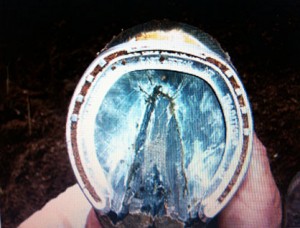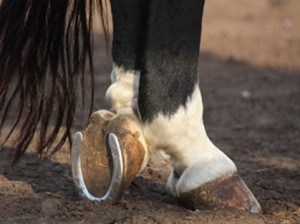Defining and Dealing With Hoof Breakover
By: Heather Smith Thomas
Breakover is a term used frequently in the horse industry, whether one is talking about “enhancing breakover” or “easing breakover.” Most farriers define breakover as the act of lifting the foot from the ground (heel coming up first) and rolling over the toe. The breakover point is the portion of the hoof that is last to leave the ground.
Travis Burns, farrier at Virginia Tech (Virginia-Maryland Regional College of Veterinary Medicine), says the foot should be trimmed or the shoe placed so the base of support is centered around the coffin joint. “For therapeutic reasons, such as with a laminitic horse, we often get more radical with breakover and may place it under the middle of the coffin joint. Looking at a radiograph, we would draw a plumb line straight down from the extensor process. This extreme breakover is an effort to reduce strain on the dorsal laminar interface between the laminar bond, the dorsal surface of the hoof wall, and the dorsal surface of the distal phalanx. By doing this, you ease some of the stresses on the palmar half of the foot,” says Burns.
However, if breakover is too far out of kilter in a normal foot, there will be extra strain on some part of the foot or leg. “A person can go too far, which would alter the natural gait of the horse,” Burns says. People often try to alter gait to suit their purposes in a specific discipline.
“I hate the terms ‘increase’ or ‘decrease breakover.’ All you can do is change the point at which it occurs. We often grind or roll the toe back to the inner web of the shoe. We can set the roll back 7/8 of an inch or whatever the web thickness is. You can look at it radiographically and see a point of breakover. But, many people argue that the horse still breaks over at the most dorsal (front) point of the shoe. This is why they may set a shoe very far back,” he says.
“There are times we need to set a shoe back radically, but if you have the foot trimmed appropriately, in a normal-footed horse, you don’t need to do this. I often roll the toe of a shoe, but the wall is a weight-bearing structure and we should always take advantage of every bit of the wall that we can,” says Burns.
“I favor rockers and rolled toes, but I’m not a big fan of squared toes and setting the shoe back. I set it back a little when needed, like half the thickness of the wall, as a safety measure. Then, if the feet hit one another, the horse is just hitting himself with the foot and not with a shoe,” says Burns.
“I don’t like to change the breakover radically, unless it’s a foundered horse or an acute laminitis, but I think every front shoe should either have a rolled toe or rocker toe to make breakover or articulation of the coffin joint easier,” he explains.
“We are simply trying to make it easier for the horse to move, staying away from the more radical things like setting the breakover very far back or changing the normal foot. When you set it too far back, you may drastically distort a hoof capsule, creating more problems than you are alleviating or hopefully preventing.”
Anything we can do to help that foot roll over and decrease strain on the palmar half of the foot and the dorsal laminae interface is helpful, but Burns wants the wall to stay weight-bearing. “I want a thicker shoe so we can roll it farther back if that’s what’s needed,” he says. The main thing is to keep the horse comfortable and take strain off the joints.
“Most people are constantly worried about the length of toe and breakover, but the whole foot needs to be healthy and balanced. An appropriate base of support is much more vital than simply addressing breakover,” says Burns.












